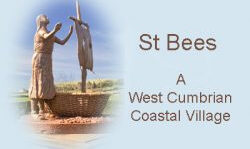Parish Council History - Parish Revolution
Chapter 1: Parish Revolution
The council is born
On the 4th December 1894, all roads in St. Bees led to the Village School; a large and excited crowd was assembling to elect the village’s first parish council.
There was a whiff of rural revolution in the air. The new Parish Councils that were being set up all over England and Wales would be the first democratically elected bodies in the parishes, and for the first time married women could vote and stand for election. Local affairs were being put in the hands of the man and woman in the street, and excitement ran high.
At 7.30 p.m. prompt the meeting started. Mr. Henry Kitchin was appointed chairman and he received nominations from nineteen candidates for the eleven seats. The vote was by a show of hands for each candidate in turn. This was to save the cost of a secret ballot, though dishonest or confused electors could use more than their allotted votes. But, as a safeguard, electors could demand a secret ballot if they were not satisfied with the fairness of the vote.
The result was declared, and St. Bees was about to have its first Parish Council. It only remained for Mr. Kitchin to allow a final opportunity for a request for a secret ballot. After an awkward silence a Mr. Brockbank spoke up, several other voters supported him, and Mr. Kitchin was obliged to nullify the vote and declare a secret ballot to be held on the 18th December.
The second election was probably justified. It attracted over twice as many voters, and three successful candidates from the first election failed to get elected.
The new council was:
Canon E. Knowles, Vicar of St. Bees and last Principal of the Theological College
William Broomfield, chemist
Henry Fox, landowner
John Bowly, clerk
William Walker, grocer & draper
Steven Graves and John Sewell, both farmers
George Scoular and Joseph Woolcock, both mining engineers
William Stafford, joiner
James Graham, boot maker
This was a interesting result. Nationally, almost half the parish council seats were taken by farmers. The other half went to craftsmen and labourers, and there was just a sprinkling of gentry, clergy, professional people and businessmen. But in St. Bees it was different. The proximity to Whitehaven and heavy industry, and the influence of the Church and School, caused those elected to come from a wider range of occupations. This was to result in an active and lively council, as we shall see.
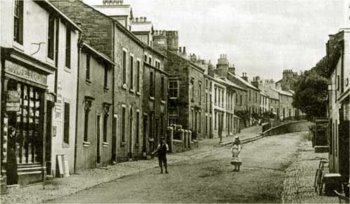
The Main Street c.1900.
Broomfield’s Chemist shop is on the left; it also housed the village telephone exchange.
The Post Office is on the right, and one of the first complaints to the Council was that horse riders were posting letters without dismounting;thereby fouling the pavement. The pavements are cobbles, and tar macadam on the road was unknown.
Rural Democracy
But why were parish councils created in 1894? Had there not been “village councils” in existence for centuries?
Prior to 1894 the only parish government in England had been the “Vestry” Meeting. This was a meeting of the ratepayers that normally met monthly in the Church Vestry; hence its name. Curiously, the “Vestry” had not been established by any law, but had evolved through practical necessity, to look after local matters such as the Poor, the Roads, the Church, the Lock-up and the Pinfold.
However, by the 1890s the “Vestry” had outlived its usefulness. It confused church and civil affairs, and it was being eclipsed by the proliferation of local “Boards” that had sprung up after each piece of legislation. By 1894 a parish could have its various needs met by a Burial Board, a Sanitation Board, a School Board, and a Water Board; to name but a few. Whilst these Boards were elected annually, they were not democratic as the large ratepayers had more than one vote. Caught between the self-created “Vestry” and the array of undemocratic Boards, Local Government was ripe for reform.
Reform was a vote-catching policy of the Liberal Party. The Vestry Meetings were seen as being controlled by the Tory Squire and Parson, and the increasing popularity of the Socialists meant the Liberals had to take the initiative if they were to remain as the party of radical reform. The response was the Local Government Act 1894, which created Parish and District Councils.
After a long, rough ride through Parliament, the Bill was finally passed on 5th March 1894. The Prime Minister, W.E. Gladstone, in the last parliamentary speech of his long and illustrious career, strongly urged its adoption, and attacked the House of Lords for their delaying tactics. There were many vested interests opposed to the Bill. Landowners feared the powers of the new councils, and large property owners thought they would be heavy spenders on the rates, whilst the Church of England feared the powers the new councils would have with parochial charities. Whilst these fears proved to be unfounded, Sir Henry Fowler, who steered the Bill through Parliament, had to rise over 800 times to speak in its defence.
Cross Hill c. 1900. The motor car has not made its appearance and the delivery cart was quite safe skewed across the road. However, by 1908 the Parish Council was asking for “danger boards” at Cross Hill and a speed limit for the Main Street. The smithy at Cross Hill used the rimming wheel opposite, and some activity can be seen there. In 1902 the barn on the far left was converted into the Co-op. |
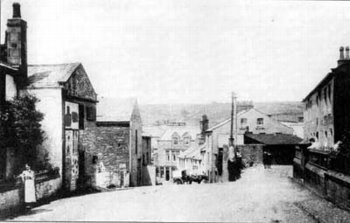
New Year and New Council
The St. Bees Council’s first meeting at 7 p.m. on New Year’s Eve 1894, was at just about the last possible moment in the year. Probably because of the evening’s forthcoming celebrations, the agenda was kept short. John Bowly, a professional civil servant, was elected Chairman, and Mr.W.E. Walker was elected Vice-Chairman. John Hartley, the Board School Headmaster, was appointed as Clerk at an annual salary of £5. The council agreed to meet monthly in the Board School, and appointed Mr. T. Machell of the Whitehaven Joint Stock Bank as Treasurer; on condition that he deposited a bond for £100.
The new Parish Council now effectively took over the remaining civil functions of the Vestry Meeting. From now on the “Vestry” would only look after Church affairs. The Vestry Meetings were finally abolished in 1922, when Parochial Church Councils were created in their place to govern the Church of England at parish level, and local civil and church government were separated.
A Socialist Utopia.
The first item of business at the first proper business meeting, in February 1895, was a bombshell for the fledgling council. Its effects are still felt 100 years later. A letter was read out from the Revd. Alfred Pagan, of Shadforth, County Durham, offering to the Council the leasehold of Town Head Farm. The farm, at the top of Seamill Lane, was valued at £1,098, with a rental of £42, which would give a considerable income to the Parish, but the conditions were far from straightforward.
Pagan had some eccentric social ideas, and wished to establish what the press subsequently described as a “Socialist Utopia”. He stipulated that the income from the farm should be invested to buy up other properties in St. Bees. The rental from these would enable further purchases, until all of the village was owned by the Parish Council ! When this was complete, £1,098 would be donated to a neighbouring parish to do the same. That parish would then do likewise, whilst St. Bees raised another £1,098 to start another parish on the same scheme, and so on..
Pagan’s theory was that the movement would spread as a chain reaction across the Country, until all the rural property in England was owned by the Parish Councils and fair rents would be charged to the poor. Understandably, the Council was split on whether to accept. The idea was obviously an impractical utopian dream. Could St. Bees really be the springboard for such a bold social experiment? It was unlikely.
After negotiations the conditions were changed so that £10 of the money accruing could be used annually for charitable purposes. The rest would be invested to further Pagan’s Utopian plan. On a very narrow majority the Council accepted the gift, and a committee was set up to look after the farm and administer the money.
Back From Utopia
Being on the parish council was no bed of roses, and whilst the philosophical arguments of the Pagan gift were going on, councillors found that they had to get down to their more mundane duties, such as collecting the rates on behalf of the Whitehaven Rural District Council.
That Council had also been created under the 1894 Act, and it looked after the roads, water, sanitation, public health, and similar matters for the whole district. The Parish Council was obliged to act as their tax gatherers, and had to employ ‘parish overseers’ who would value the properties in the village and collect the rates.
In return, the Parish immediately pursued the District Council to improve the Village roads and pavements. They got them to take over and improve the Abbey Road, which was the only public road to the beach (Lord Lonsdale owned the “Coach Road”), and to repair the cobbled pavements of the Main Street. These were in poor repair, partly due to horse riders using them. The Main Street had been straightened some years earlier leaving the old road at a higher level with an unfenced drop. The Parish Council soon got the District Council to erect the present railings.
The Council set about a variety of initiatives to improve the Village. They had powers to maintain public footpaths. Overgrown footpaths were cleared and obstructions removed. Two new footbridges were built, one over Rottington Beck at the sea outfall at Gutter Foot, and one on the path from Blythe Place to Seamill. After 1899 the Council was also responsible for common land. In St. Bees there was little common land left, but they won a battle over a blocked access to the public watering place at the top of Outrigg. The maintenance of public seats was taken over from the St. Bees “Visitors Committee”, which had originally installed them. This committee promoted tourism by producing publicity leaflets and by improving amenities for visitors.
The Council tackled a host of other minor issues. They had drinking water piped to the Seacote Beach, obtained access to the Recreation Ground for village children, got the Furness Railway to deliver parcels free from the station and numbered the houses in the Main Street – up one side and down the other!
Gutter foot bridge. This new bridge was one of the council’s first improvements in the parish. |
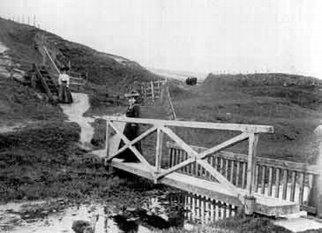
Let There Still Be Light
St. Bees had prided itself on being one of the first villages in the district to have gas street lighting. A Public Lighting Committee had looked after street lighting since the 1860s. The Council now inherited this task and a sub-committee was formed which had regular and vociferous public meetings. The Council employed a lamplighter, and gas was bought from the St. Bees Gas Company; all of which was paid for by a rate collected by the overseers. The Gas Company had its own works near the present sewage works, and gas was produced in retorts by roasting coal brought in on the railway. One of the Council’s first improvement projects was the extension of public street lighting to the “Preston Quarter” area, north of Pow Beck, but it took many years of debate and public meetings before the ratepayers agreed on a scheme.
The Parish Divided
With so many parish councils to set up in 1894, the Government used the old “Poor Law Parish” boundaries for convenience. The large church parish of St. Bees had been divided into four such parishes. Pow Beck was the border between two of them; St. Bees Quarter in the south, and Preston Quarter in the north. This meant that about 100 villagers and much of St. Bees School were in the separate parish of Preston Quarter which extended as far as Newtown in Whitehaven.
This split in the village was unacceptable, and in 1895 the St. Bees Parish Council, backed by St. Bees School, applied to have the boundaries moved north so that St. Bees included all the population in the valley. An Enquiry was held at the Union Hall in Whitehaven by the County Council, and the boundaries were changed. The enlarged population of St. Bees Parish meant the number of councillors could be increased to 13.
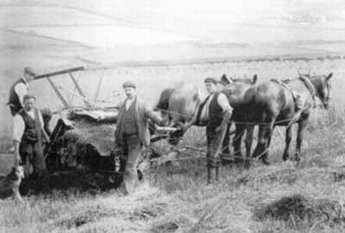
Reaper-Binder in action c 1900.
The Smith family is harvesting on Tomlin. The horse was still the mainstay of motive power in agriculture before the First World War.
The Parish Poor
Before the days of the Welfare State, the unemployed, poor and homeless of the Parish were looked after by the Whitehaven Poor Law Union. This covered Whitehaven and the 25 parishes stretching from Gosforth to Harrington, with a total population of 60,000. A “Poor Rate”, £185 in 1896, was collected by the parish overseers, and this paid for the workhouse at Meadow View at the bottom of Greenbank Hill, in which there were about 300 inmates.
Later, in 1914, St. Bees had a Children’s Home (where Mitchell’s shop is now) which housed children from the Whitehaven Union in a more suitable atmosphere than the workhouse. The children attended the village school and were effectively part of the community.
For poorer St. Bees residents, help was also available from the Shepherd’s Charity and the Pagan gift. The Shepherd’s charity had been established in 1863 with a gift of £700 from a Miss Shepherd. Since then it had been administered solely by the Church, but it now had Parish Council representatives on its committee. This charity and the Pagan gift did much to help widows and older people by six-monthly payments made at the discretion of their committees.
Education
The St. Bees Board School was built in 1875, and was run by a “Board” of managers who financed it by a rate collected by the overseers. In return, the Parish Council had two managers on the Board. Initially the school was divided into an Infant’s and a Junior Boys’ section; junior girls were educated elsewhere in the village. In 1897 it was enlarged to become a “mixed” school of over 200 pupils, by converting the adjoining headmaster’s house into extra classrooms, and admitting junior girls.
The school was run locally by the Board until 1902, when state education was turned over to the County Councils. There was then a joint board for both St. Bees and Sandwith schools, but this apparently didn’t work very well. Matters finally came to a head in 1906 when the St. Bees Parish Council managers walked out: after this the schools were run by separate boards.
There was no state secondary education, and village children were educated entirely at the Board School until leaving at 13. Consequently there was a demand for adult education, and to meet this the Parish Council formed a Technical Education sub-committee. In 1896 they got off to a flying start by organising popular evening classes in the Board School on first aid and basic veterinary practice.
The Council also sent three representatives to the Whitehaven District Technical Education Committee and they were involved in discussions to establish the Workington Technical College.
Village Festivities
The Village was a lively place for home-made entertainment. Typical was a “Parochial Tea, Concert and Whist Drive” held in the Village School in 1913. It started in early evening and finished at 3 a.m. after a dance to music by the Harding Brothers. On a more civilised timetable the Methodist Chapel held annual concerts in Hodgett’s Club, which ran for several nights to meet demand. Any event seemed to be an excuse for a dinner at one the village’s hotels. Such as in 1908 when there was a grand dinner in the Seacote with innumerable speeches, songs and toasts from village worthies to celebrate the 50 years service of Mossop Sharp as a bell ringer.
The Parish Council splashed out in 1911 when they donated £70 (about £2,500 today) to pay for festivities for the Coronation of King George V. On the day, a procession of the St. Bees Oddfellows, the St. Bees Territorials and the Parish Council was led by the Cleator Moor St. John’s Temperance Band to a service at the Priory. After lunch, which for the Territorials was in the Queens Arms Hotel at the expense of Colonel Dixon, the procession re-formed at Town Head. With the village school children they marched to St. Bees School where there were maypole dancing, footraces and wrestling matches. Later there was an open air dance at the “Green” at the Seacote, and a monster bonfire on Tomlin.
Leading figures of the parish at the 1911 celebrations of the coronation of King George V.
L to R Back row, T E G Marley; industrialist, Rev A Ainley; Vicar, Captain Huck; science master at St. Bees School, John Hartley; Headmaster of the Village school.
Front row, Henry Kitchin, John Bowly; Parish Council Chairman, Henry Fox; Landowner, James Graham; Postmaster, J D Kenworthy; Artist. Picture taken on the terrace of St. Bees School by F J Livesey, the Priory organist.
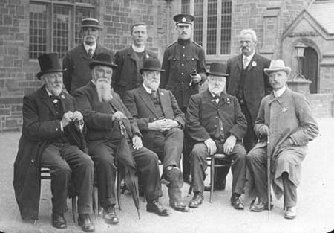
For serious music lovers there were the organ recitals in the Priory given by the Priory organist, Francis J. Livesey, and a galaxy of famous players. Livesey himself was an accomplished organist. He had been assistant to G.R. Sinclair (the “G.R.S”. of the Enigma Variations), who was the organist at Hereford cathedral, and who was a great friend of Edward Elgar. Livesey used to stand in at Hereford when the cathedral organist was on holiday.
Visiting organists stayed with George Dixon at Fern Bank, High House Road, and were usually expected to give a recital in return for their board. Dixon was building a reputation as an organ designer of national fame, and amongst his early works were the designs for the rebuilding of Trinity, St. John’s, and King’s College organs at Cambridge.
The Self-Sufficient Community
The Village was largely self-sufficient, and had an array of shops and services. In 1901 there were a coal agent, a draper, a hardware store, a chemist, a butcher, two blacksmiths, two bakers, and several grocers. The slaughter house at the bottom of Outrigg provided fresh meat, and flour was produced at Walkers Scone Flour factory on Cross Hill.
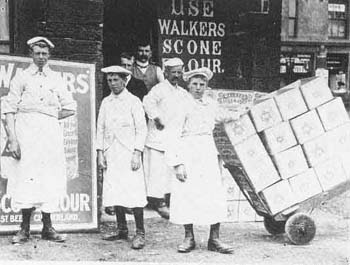
Walker’s Scone Flour Factory at Cross Hill. c.1900.
Walkers also produced “St. Bees Sauce” in the pickle factory at Finkle Hall, and “Early Riser” baking powder, which was proudly loaded into railway vans for dispatch to that mysterious place, the South of England.
Brownriggs of Finkle Street offered horse-drawn coach tours of the western lakes and from his shop at 22 Main Street, the village chemist, R.W. Broomfield, sold his own emulsion of Norwegian cod liver oil and hypophosphites at 10d. a bottle.
Those with a sporting bent could play rugby, football or cricket on the Recreation Ground, golf on the old course near Coulderton, or bowls at what are now the tennis courts at the Seacote. Or they could hunt with the St. Bees Beagles which were kennelled at the Seacote, and which under Mr. J.J. Thompson was one of the most successful packs in the County.
| St. Bees Beagles at Orchard Brow, Haile, in 1904. The present-day “Black Combe Beagles” is the descendant of this pack. |
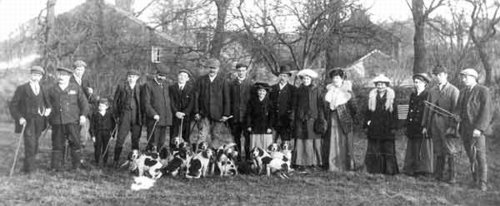
Stone of Contention
Whilst the 1894 Act simplified local government, the District Council complicated it by appointing a “Parochial Committee” for St. Bees. This committee was nothing to do with the Parish Council, and on the District’s behalf it looked after the Water Supply, the Fire Engine, the Roads and the Dustcart. Sometimes the Parish was not big enough for both this committee and the Parish Council.
In 1910 matters came to a head when Canon H.A.P. Sawyer, the affable St. Bees School Headmaster, noticed that the historic coat of arms of Archbishop Grindal dating from 1585 on the old Pow Beck Bridge had suffered from an Edwardian vandal. To preserve the stone, he approached the Parochial Committee, which sanctioned removal of the stone by the County Council to St. Bees School.
The Parish Council remained unaware of these plans until the stone was gone and councillors were collared in the street by irate villagers. They felt the stone was the property of the Village, and it had now been hidden away in some corner of the Grammar School. The storm broke at a meeting of the Whitehaven Rural District Council when Tom McKay, who was both a Parish and a District Councillor, tried to censure the County Council for its action. Unfortunately, he met with little support as the District Council’s own surveyor had also been involved in removing the stone. The only body which did not ’t know in advance was the Parish Council.
The columns of the Press were filled with heated debate, and the matter threatened to get out of hand. At the bottom of the rumpus was the simple question: “Who runs the Parish?”. Nobody had consulted the Parish Council about the Stone, and it was this that rankled. Calm prevailed when it was agreed that a replica be placed on the bridge. Mr. McKay donated the rough stone from his Bankend quarry, and the carving was paid for by public subscription. This is the stone you see today on the bridge. The original is at the School, in a passage off the Quadrangle. Spare a thought for this battle when next you cross the bridge.
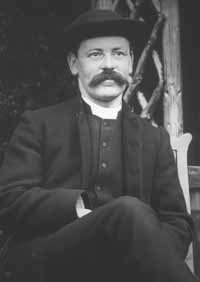
The Revd Henry Burgh.
This popular curate chaired many council elections and served on the council.
For Those in Peril…
Shipwreck was no stranger to St. Bees. The Priory burial register carries many entries; “Body of an unknown man, washed up on the shore”. Because in those days bodies had to be buried quickly, an inquest would be immediately convened to allow burial. The identity would usually be established later.
Such an incident was on Christmas Day 1901, when a body was washed up at Nethertown. An inquest was quickly convened, and by the possessions the body was concluded to be that of a Cornishman. He was buried as an “unknown person”, and notices describing the body were put in the Cornish papers. After reading one of these, his daughter wrote to the Coroner identifying the body from the description. It was established that the body was of Captain William Ivey of Padstow, whose schooner, the “W.R.T.” of Truro, had foundered on December 21st. He left a widow and eight children.
Undoubtedly the biggest wreck at St. Bees was in May 1907, when the SS. Izaro, a steel screw steamer of Bilbao, en route from Carthagena to Maryport with a cargo of iron ore, ran aground in thick fog at the foot of Tomlin and was holed forward. Formerly the “SS Edith” built by the Grangemouth Dockyard Company in 1890, the Izaro was 1773 tons gross and 259 feet long.
The Whitehaven Rocket Brigade and the Whitehaven lifeboat were both called out, but the crew managed to get off safely, and the lifeboat returned. The Rocket Brigade used rockets to send lifelines to remove the crews of stricken ships. This would have been a classic cliff-top rescue for them , but they were turned back at Preston Street in Whitehaven.
The Izaro was held on the rocks, and the crew re-boarded as there was some hope of re-floating. However, after 3 days of movement she broke her back, and she was sold for salvage. The crew left, and the removal of over 700 tons of ore started a few days later, using a shallow draught steam lighter sent from Liverpool. This took four months to complete, after which she was cut up for scrap. Only the keel and the boilers were left, and they can still be seen at low spring tides.
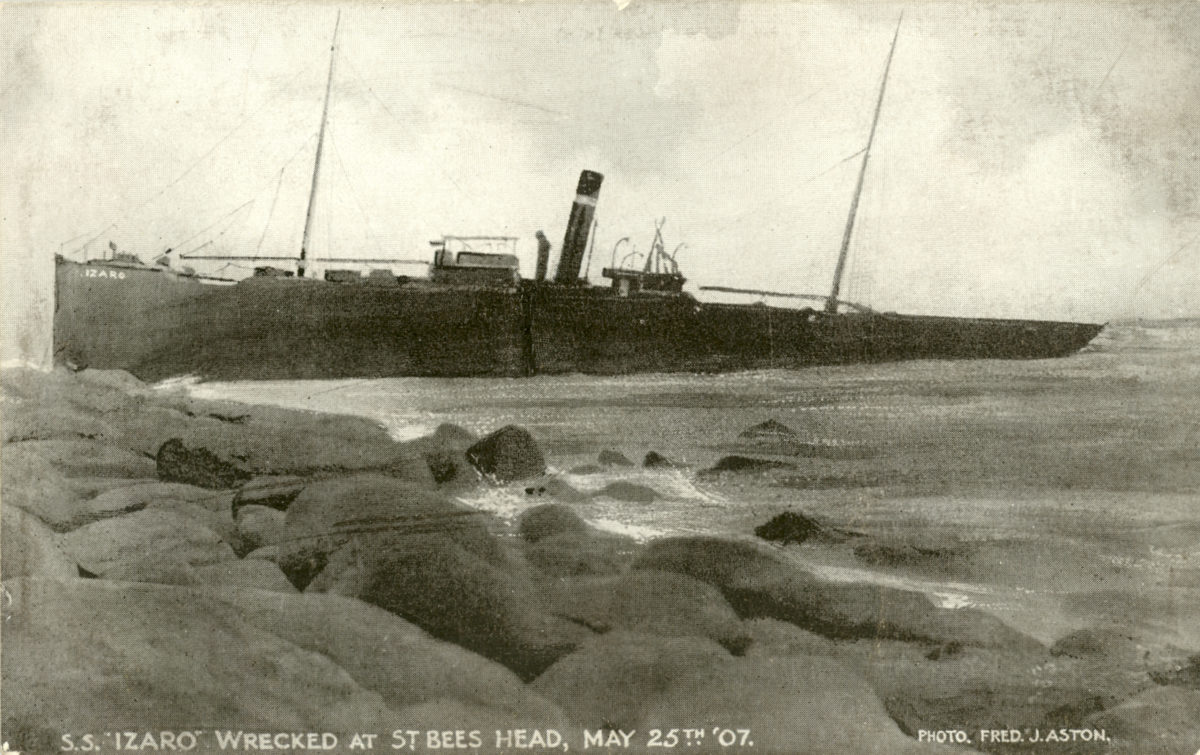
The Izaro – held fast on the rocks
The Early Councillors.
Despite a decline of interest nationally in parish councils in the 1900s, in St. Bees elections continued to be well contested. Church and School had been represented by the Revd. E. Knowles, Vicar until 1897, and Revd. H.T. Newbold, the Grammar School Headmaster until 1903. But status was not an automatic vote winner. Later, in 1904 their successors, Revd. H. Snape and Revd. H.A.P. Sawyer, both stood but neither was elected. However, the Curate, the popular Revd. Henry Burgh, romped home. Such is the power of the secret ballot.
The pre-war years brought the deaths of two stalwarts of the council’s early days, who typified the calibre of person attracted to the council.
The Council’s first Chairman, John Bowly, died in office on December 14th 1911 aged 69. An able and experienced Civil Servant, he came to West Cumbria in 1877 after serving as Clerk to the massive St. Saviour’s Poor Law Union in London in which there were no less than 350 Poor Law parishes to administer.
His first appointment in West Cumberland was Clerk to the Egremont Local Board, and over the years he held many important local government posts. He seemed unable to retire, and at 67 he was still Clerk to three district councils and one water committee, and Assistant Registrar to the Whitehaven Board of Guardians.
Reported in the press as being a “confirmed and genial bachelor”, he was obviously astute; he left an estate of nearly £16,000 (£640,000 today). Bowly’s handling of the Council in its formative years earned it great respect. Under his chairmanship the Council got on and did things when there were still many voices questioning whether parish councils should exist.
For the epitome of the successful industrialist, we must turn to George Scoular of Fleatham House. He was one of those Victorian self-made characters who straddled business, local politics and community affairs. The son of a Scottish blast-furnace man, he came to the area in 1870 as Engineer to the Parkside Mining Co. near Frizington. He spread his influence to the Outerside, Ellenborough, Flimby and Broughton Moor Collieries, and at his death he was also Managing Director of the St. Helens Colliery, Siddick. A staunch supporter of the YMCA and a member of the Whitehaven Technical Education Committee, he was also Chairman of the St. Bees Parochial Committee, a “Liberal Conservative” County Councillor for Trinity Ward, Whitehaven, and a founder member of the St. Bees Parish Council. His death in March 1912 removed another able member from the council.
The deaths of Bowly and Scoular marked the ending of a golden chapter in village life. For rural England it had been a good time. Prosperity and standards of living had increased, the railways had reached most corners of the country, and public health had improved dramatically. But the clouds were gathering.
It was up to the new Chairman, T.E.G. Marley of Monks Croft, to take the helm. But there was little time to exercise new initiatives, as Europe moved inexorably towards the horrors of the First World War.
Mr T E G Marley
Appointed Chairman of the parish council just before the outbreak of WW1. He was Managing Director of the Whitehaven Haematite Iron & Steel Co., the Derwent Bridge & Boiler Co., and General Manager of the Lowca Engineering Company. A President of the St. Bees Horticultural Society, he was also chairman of the Recreation Ground Committee.
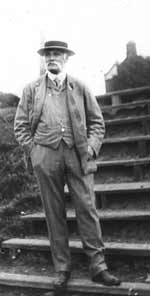
Copyright D T Sim 1995 and 2004.
Adapted from the booklet “100 years of St. Bees”, published in 1995 by St. Bees Parish Council, to celebrate 100 years of parish councils.
